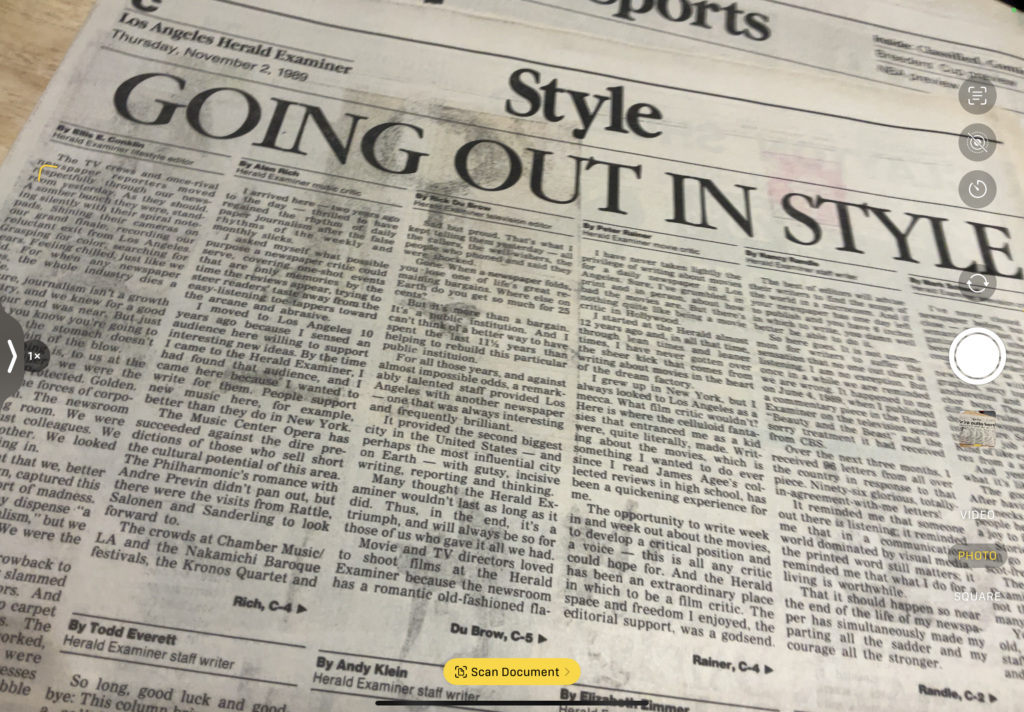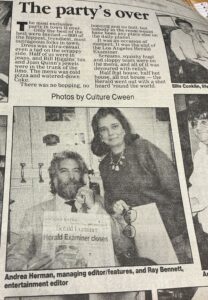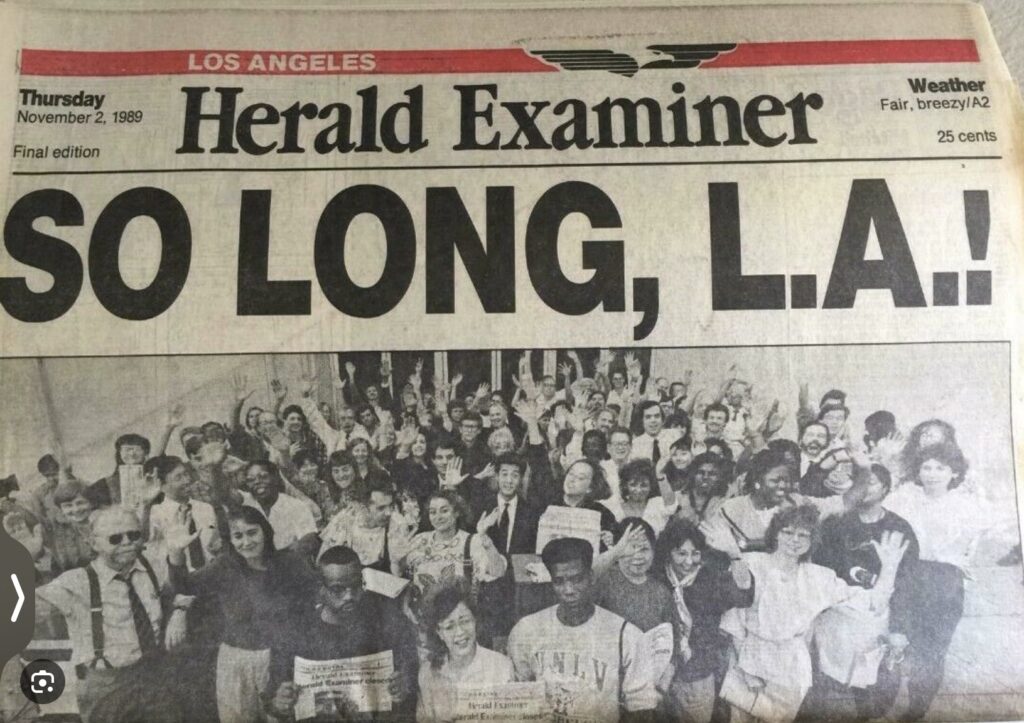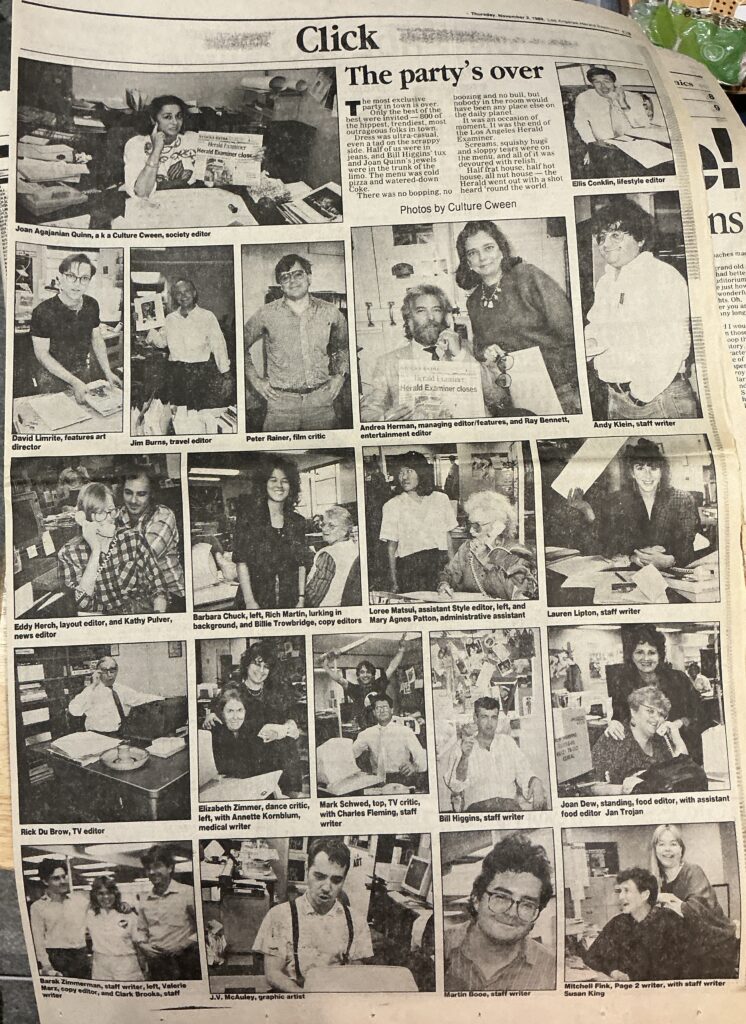As people came into work at the Los Angeles Herald Examiner newspaper on Nov, 1 1989, everyone appeared to be on edge. There was something in the air. We had a desultory budget meeting and all managing editor Andrea Herman would say was that brass from Hearst, owners of the paper, were in town. Alarming calls came in with various rumours that the paper been sold or was going to fold. At noon, a bunch of us went to Corky’s, our local watering hole next door, where there was a Times reporter making notes.
At 12.55, word came of a staff meeting at one o’clock. Everyone gathered in the newsroom. Hearst Corp. Vice President Robert J. Danzig got up on a chair, his head bent so as not to bump into the ceiling. He said there was no other way to tell us what was happening than to read a prepared statement he had given to Editor Max McCrohon earlier. After 86 years, the Herald Examiner was to cease publication the next day, November 2.
 Some old-timers absorbed the news with no visible reaction; some wept. Most stood or sat stunned although it should not have been a surprise. The Herald Examiner had been dying slowly for twenty years after it made a pact that gave mornings to the Los Angeles Times and the HerEx became an afternoon paper. Not the best move in a city where all the commuters are behind the wheel of a car. Still, we’d all told ourselves we would have another year. Danzig said that he was sorry and Hearst did all they could and the paper had never looked better. I drifted away. It was not really about me as I had been the Entertainment Editor only since July.
Some old-timers absorbed the news with no visible reaction; some wept. Most stood or sat stunned although it should not have been a surprise. The Herald Examiner had been dying slowly for twenty years after it made a pact that gave mornings to the Los Angeles Times and the HerEx became an afternoon paper. Not the best move in a city where all the commuters are behind the wheel of a car. Still, we’d all told ourselves we would have another year. Danzig said that he was sorry and Hearst did all they could and the paper had never looked better. I drifted away. It was not really about me as I had been the Entertainment Editor only since July.
At another budget meeting, Lifestyle Editor Ellis Conklin said he wanted to write a farewell column. I told Andrea Herman we should give over all the pages in the Style section to the critics and writers, ten inches for everyone who wanted to contribute. Theatre critic Charles Marowitz was on a plane to New York and art critic Christopher Knight was off in Mexico somewhere and could not be contacted. Lifestyle feature writer Deborah Hastings came in even though she was on vacation.
Andrea had some idea of running a ‘Best of Click’ page, our regular photo spread featuring notables in the city. ‘No, Andrea,’ I told her, ‘photographers have been taking pictures all day in the office. It’s the biggest story in town. We must run those pix.’ Ellis agreed and so did Max McCrohon.
 It was the craziest, best and worst day I’ve ever spent in journalism. All afternoon, I edited the farewell columns. They were all good, funny and touching. We added two extra pages to the section so we could still run stories that had been written and edited earlier.
It was the craziest, best and worst day I’ve ever spent in journalism. All afternoon, I edited the farewell columns. They were all good, funny and touching. We added two extra pages to the section so we could still run stories that had been written and edited earlier.
At four-o’clock, we all went out to the front of the building for a group shot to run on the front page. People were waving at the camera and singing ‘Auld Lang Syne’. Pix were taken and we drifted back inside only to learn that security goons had locked the doors with Andrea, Max and News Editor Joe Eckdahl still inside so we all trooped back outside to do it over again.
We worked all through the evening, back and forth from Corky’s. There were TV crews in the bar and in the newspaper lobby there was a frenzy of media. Three recruiters from the Orange County Register came to Corky’s and calls were coming in from papers across the nation.
We closed the paper just before nine. Some of us went to the press room to see the final run. Corky’s was unbelievable. There must have been 200 people crowded into the place. Lots of former staffers joined us and it went on until three in the morning.
Next day, tired and more still inebriated than hungover, we had to sign in to enter the building. We were told we had that day and the next to remove our stuff. No one appeared to have a job lined up yet although there was lots of activity and film writer Charles Fleming had already arranged two interviews. Several staffers did radio interviews and Charles called into a live chat show saying he was ‘Mac from Pacoima’ and he was ‘all busticated up inside’ about losing the paper. He was hilarious.
We had lunch at Corky’s and went back and forth all day. People said copies of the final edition were going for fifty bucks and there was a run on tee-shirts. I made sure I had a stack of both to take with me. Lots of parties were planned so no one wanted to actually say goodbye to anyone.
In the Washington Post’s story about the closure, newspaper industry analyst John Morton said, ’It’s a shame. They were doing a good job. In the year of its death, it was probably the best it has ever been as a newspaper.’
That evening, a group of us from the paper including Charles Fleming, Mark Schwed, Deborah Hastings, Greg Krikorian and columnist Gordon Dillow went to Dan Tana’s, the fabled West Hollywood restaurant. As we waited just inside the door, somebody recognised Gordon from the photo on his column in the paper and Jimmy Cano, the city’s best maitre’d, asked if we were all from the Herald Examiner.
When we said we were, everyone in the place applauded. Famous for not fussing over its starry clientele, that never happens. Legendary bartender Mike Gotovac poured Stoli as diners called in drinks for us. We weren’t allowed to pay for anything. It was the start of a beautiful friendship.
I was very glad to be a part of it all and very sad that such a great enterprise with fine people had been cut so abruptly. I didn’t think I’d see its like again. My four-month stint at the Herald Examiner still ranks among the best times of my career and I made lifelong friends there.
I will never forget watching the final press run of a great newspaper but it struck me that as we approached the twenty-first century, the one thing I was really good at was a nineteenth century trade.



